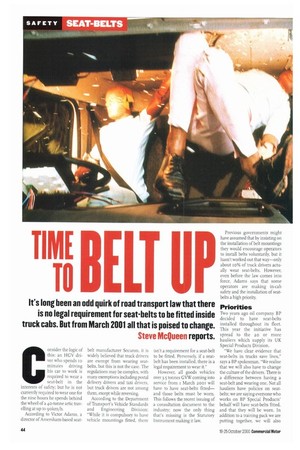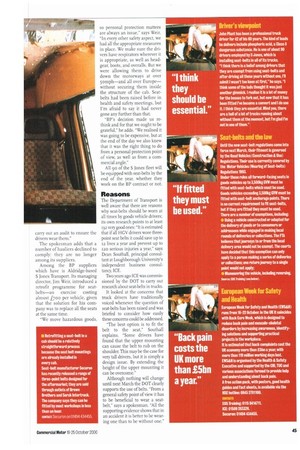It's long been an odd quirk of road transport law
Page 46

Page 47

If you've noticed an error in this article please click here to report it so we can fix it.
that there is no legal requirement for seat-belts to be fitted inside truck cabs. But from March 2001 all that is poised to change. Steve McQueen reports.
Consider the logic of this: an HGV driver who spends 1 o minutes driving his car to work is required to wear a seat-belt in the interests of safety; but he is not currently required to wear one for the nine hours he spends behind the wheel of a 4o-tonne artic travelling at up to 90km/h.
According to Victor Adams, a director of A mersham-based seat44 belt manufacturer Securon, it is widely believed that truck drivers are exempt from wearing seatbelts, but this is not the case. The regulations may be complex, with many exemptions including postal delivery drivers and taxi drivers, but truck drivers are not among them, except while reversing.
According to the Department of Transport's Vehicle Standards and Engineering Division: "While it is compulsory to have vehicle mountings fitted, there isn't a requirement for a seat-belt to be fitted. Perversely, if a seatbelt has been installed, there is a legal requirement to wear it."
However, all goods vehicles over 3.5 tonnes GVW coming into service from i March 2001 will have to have seat-belts fitted— and those belts must be worn. This follows the recent issuing of a consultation document to the industry; now the only thing that's missing is the Statutory Instrument making it law.
Previous governments might have assumed that by insisting on the installation of belt mountings they would encourage operators to install belts voluntarily, but it hasn't worked out that way—only about io% of truck drivers actually wear seat-belts, However. even before the law comes into force, Adams says that some operators are making in-cab safety and the installation of seatbelts a high priority.
Priorities
Two years ago oil company BP decided to have seat-belts installed throughout its fleet. This year the initiative has spread to the zo or more hauliers which supply its UK Special Products Division.
"We have clear evidence that seat-belts in trucks save lives," says a BP spokesman. "We realise that we will also have to change the culture of the drivers. There is a difference between having a scat-belt and wearing one. Not all hauliers have policies on seatbelts; we are saying everyone who works on BP Special Products' behalf will have seat-belts fitted, and that they will be worn. In addition to a training pack we are putting together, we will also carry out an audit to ensure the drivers wear them."
The spokesman adds that a number of hauliers declined to comply: they are no longer among its suppliers.
Among the BP suppliers which have is Aldridge-based S Jones Transport. Its managing director, Jim Weir, introduced a retrofit programme for seatbelts—an exercise costing almost £700 per vehicle, given that the solution for his company was to replace all the seats at the same time.
"We move hazardous goods, so personal protection matters are always an issue," says Weir. "In every other safety aspect, we had all the appropriate measures in place. We make sure the drivers have respirators wherever it is appropriate, as well as headgear, boots, and overalls. But we were allowing them to drive down the motorways at over 50mph—and all over Europe— without securing them inside the structure of the cab. Seatbelts had been raised before in health and safety meetings, but I'm afraid to say it had never gone any further than that.
"BP's decision made us rethink and for that we ought to be grateful," he adds. "We realised it was going to be expensive, but at the end of the day we also knew that it was the right thing to do from a personal protection point of view, as well as from a commercial angle."
All sio of the S Jones fleet will be equipped with seat-belts by the end of the year, whether they work on the BP contract or not.
Reasons
The Department of Transport is well aware that there are reasons why seat-belts should be worn at all times by goods vehicle drivers; its own research points to at least 132 very good ones: "It is estimated that if all HGV drivers wore threepoint seat belts it could save up to 12 lives a year and prevent up to 120 serious injuries a year" says Dean Southall, principal consultant at Loughborough University's independent business consult.ancy, ICE.
Two years ago ICE was commissioned by the DOT to carry out research about seat-belts in trucks.
It looked at the concerns that truck drivers have traditionally voiced whenever the question of seat-belts has been raised and was briefed to consider how easily these concerns could be addressed.
"The best option is to fit the belt to the seat," Southall explains. "Some drivers have found that the upper mounting can cause the belt to rub on the shoulder. This may be the case for very tall drivers, but it is simply a design issue. By extending the height of the upper mounting it can be overcome."
Although nothing will change until next March the DOT clearly supports the use of belts. "From a general safety point of view it has to be beneficial to wear a seatbelt," says a spokesman. "All the supporting evidence shows that in an accident it is better to be wearing one than to be without one."












































































































